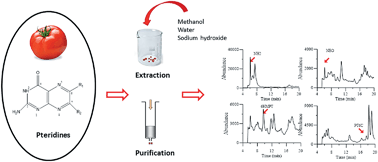Development of an HPLC-MS method for the determination of natural pteridines in tomato samples
Abstract
In plants, reduced pteridines are folate biosynthesis intermediates, and the presence of these analytes in biofortification processes is considered crucial. A simple liquid chromatography-mass spectrometry (LC-ESI-MS) method has been optimized for the determination of natural pteridines in tomato samples. A solid phase extraction (SPE) step using ISOLUTE ENV cartridges has been employed for cleaning up the samples. Eleven pteridines have been assayed but only four of them have been detected and quantified in tomatoes. The stability of the pteridines and hydropteridines in tomato extracts has been studied. Validation parameters have been evaluated and good linearity (R2 > 0.99 in all cases) and precision (interday relative standard deviation values were lower than 10%) were obtained. The amounts (as μg per g of fresh sample) found of each pteridine were 0.019, 0.44, 0.043 and 0.087 for neopterin, 7,8-dihydroneopterin, 6-hydroxymethylpterin and pterin-6-carboxylic acid, respectively.


 Please wait while we load your content...
Please wait while we load your content...